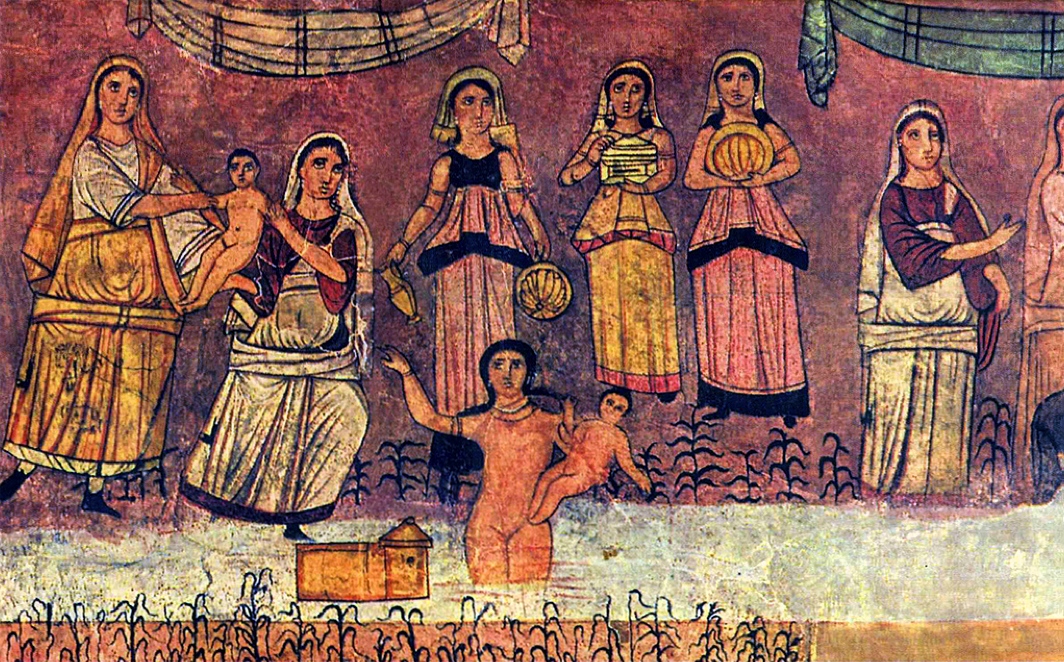
『出エジプト記』あるいは「脱出の記録」
Book of Exodus
Finding of Moses in the Dura-Europos synagogue, c. 244
☆ 出エジプト記(The Book of Exodus;古代ギリシャ語:Ἔξοδος、ローマ字表記:Éxodos: 聖書ヘブライ語: שְֹת Šəmōṯ, 'Names'; ラテン語: 出エジプト記』(Liber Exodus)は、聖書の第2巻。出エジプト記の物語であり、聖書のエジプトで奴隷の身であったイスラエルの民が、ヤハウェという神の力によって奴隷の身 から解放されたという起源神話である。その後、イスラエルの民は伝説の預言者モーセとともにシナイ山へと旅立ち、そこでヤハウェは10の戒めを与え、彼ら はヤハウェと契約を結ぶ。ヤハウェは、彼らが忠実であることを条件に「聖なる国民、祭司の王国」とすることを約束する。ヤハウェは彼らに掟を与え、幕屋を 建てるように指示する。幕屋とは、ヤハウェが天からやってきて彼らと共に住み、聖戦に導いてカナンを征服するための手段である。
| The Book of Exodus
(from Ancient Greek: Ἔξοδος, romanized: Éxodos; Biblical Hebrew:
שְׁמוֹת Šəmōṯ, 'Names'; Latin: Liber Exodus) is the second book of the
Bible. It is a narrative of the Exodus, the origin myth of the
Israelites leaving slavery in Biblical Egypt through the strength of
their deity named Yahweh, who according to the story chose them as his
people. The Israelites then journey with the legendary prophet Moses to
Mount Sinai, where Yahweh gives the 10 commandments and they enter into
a covenant with Yahweh, who promises to make them a "holy nation, and a
kingdom of priests" on condition of their faithfulness. He gives them
their laws and instructions to build the Tabernacle, the means by which
he will come from heaven and dwell with them and lead them in a holy
war to conquer Canaan (the "Promised Land"), which has earlier,
according to the myth of Genesis, been promised to the "seed" of
Abraham, the legendary patriarch of the Israelites. Traditionally ascribed to Moses himself, modern scholars see its initial composition as a product of the Babylonian exile (6th century BCE), based on earlier written sources and oral traditions, with final revisions in the Persian post-exilic period (5th century BCE).[1][2] American biblical scholar Carol Meyers, in her commentary on Exodus, suggests that it is arguably the most important book in the Bible, as it presents the defining features of Israel's identity—memories of a past marked by hardship and escape, a binding covenant with their God, who chooses Israel, and the establishment of the life of the community and the guidelines for sustaining it.[3] The consensus of modern scholars is that the Pentateuch does not give an accurate account of the origins of the Israelites, who appear instead to have formed as an entity in the central highlands of Canaan in the late second millennium BCE (around the time of the Late Bronze Age collapse) from the indigenous Canaanite culture.[4][5][6] |
出エジプト記(The Book of Exodus;
古代ギリシャ語:Ἔξοδος、ローマ字表記:Éxodos: 聖書ヘブライ語: שְֹת Šəmōṯ, 'Names'; ラテン語:
出エジプト記』(Liber
Exodus)は、聖書の第2巻。出エジプト記の物語であり、聖書のエジプトで奴隷の身であったイスラエルの民が、ヤハウェという神の力によって奴隷の身
から解放されたという起源神話である。その後、イスラエルの民は伝説の預言者モーセとともにシナイ山へと旅立ち、そこでヤハウェは10の戒めを与え、彼ら
はヤハウェと契約を結ぶ。ヤハウェは、彼らが忠実であることを条件に「聖なる国民、祭司の王国」とすることを約束する。ヤハウェは彼らに掟を与え、幕屋を
建てるように指示する。幕屋とは、ヤハウェが天からやってきて彼らと共に住み、聖戦に導いてカナンを征服するための手段である。 伝統的にモーセ自身によるものとされてきたが、現代の学者たちは、この書の最初の構成はバビロン追放時代(前6世紀)の産物であり、それ以前の文書資料と 口承伝承に基づいており、最終的な改訂はペルシャの滅亡後(前5世紀)に行われたと見ている。 [1][2]アメリカの聖書学者であるキャロル・マイヤーズは、出エジプト記の注解の中で、出エジプト記は間違いなく聖書の中で最も重要な書物であると示 唆している。それは、イスラエルのアイデンティティの決定的な特徴-苦難と逃亡によって特徴づけられた過去の記憶、イスラエルを選んだ神との拘束力のある 契約、共同体の生活の確立とそれを維持するための指針-を提示しているからである。 [3]現代の学者のコンセンサスとしては、五書ではイスラエル人の起源について正確な説明はなされておらず、その代わりに紀元前2千年紀後半(青銅器時代 後期の崩壊の頃)にカナンの中央高地で土着のカナン文化から形成されたと考えられている[4][5][6]。 |
| Title The English name Exodus comes from the Ancient Greek: ἔξοδος, romanized: éxodos, lit. 'way out', from ἐξ-, ex-, 'out' and ὁδός, hodós, 'path', 'road'. In Hebrew the book's title is שְׁמוֹת, shemōt, "Names", from the beginning words of the text: "These are the names of the sons of Israel" (Hebrew: וְאֵלֶּה שְׁמֹות בְּנֵי יִשְׂרָאֵל).[7] Historicity Main article: Sources and parallels of the Exodus 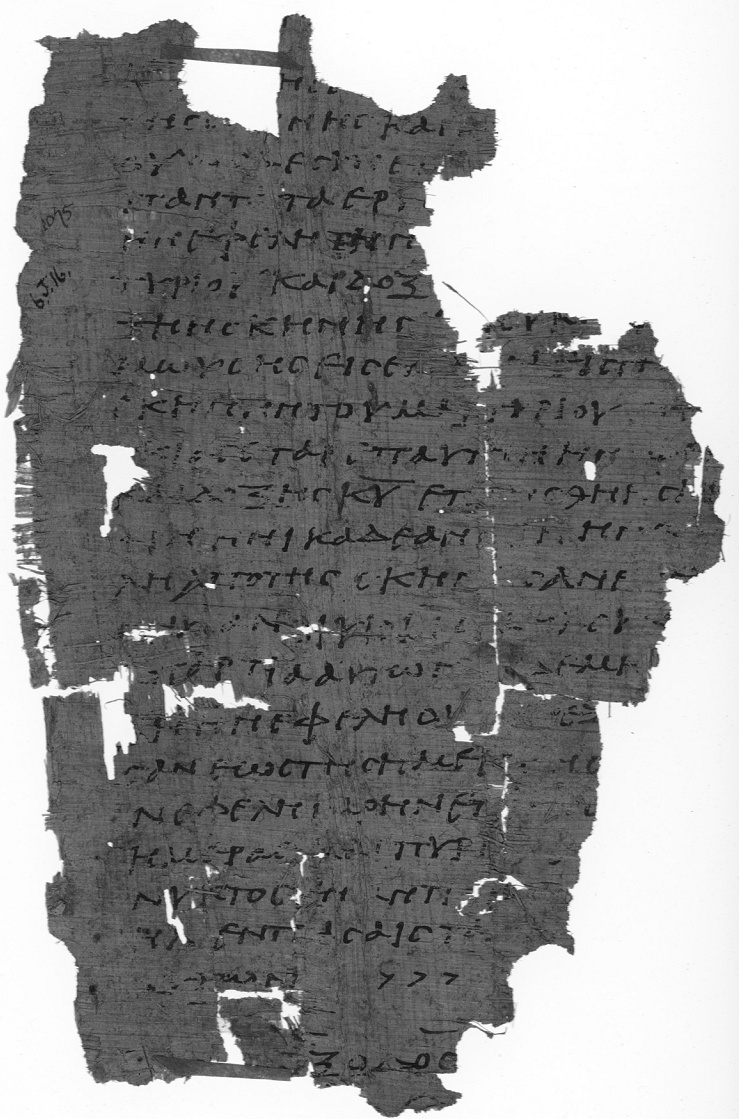 Papyrus Oxyrhynchus 1075, a 3rd or 4th century CE manuscript showing part of Exodus 40 Most mainstream scholars do not accept the biblical Exodus account as historical for a number of reasons. It is generally agreed that the Exodus stories were written centuries after the apparent setting of the stories.[6] Archaeologists Israel Finkelstein and Neil Asher Silberman argue that archaeology has not found evidence for even a small band of wandering Israelites living in the Sinai: "The conclusion – that Exodus did not happen at the time and in the manner described in the Bible – seems irrefutable [...] repeated excavations and surveys throughout the entire area have not provided even the slightest evidence".[8] Instead, they argue how modern archaeology suggests continuity between Canaanite and Israelite settlements, indicating a heavily Canaanite origin for Israel, with little suggestion that a group of foreigners from Egypt comprised early Israel.[9][10] However, a majority of scholars believe that the story has some historical basis,[11][12] though disagreeing widely about what that historical kernel might have been.[13] Kenton Sparks refers to it as "charter myth" and "mythologized history".[14] Biblical scholar Graham I. Davies notes that several literary texts from Ancient Egypt document the presence of Semitic peoples working for building projects under the 19th Dynasty of Egypt, suggesting a possible historical basis for the account of Israelite servitude to the Egyptians.[15] However, there is an increasing trend among scholars to see the biblical exodus traditions as the invention of the exilic and post-exilic Jewish community, with little to no historical basis.[16] |
タイトル エクソダスという英語名は、古代ギリシャ語のἔξοδος(ローマ字表記:éxodos)に由来する。 ἐξ-, ex-, 「出る」と ὁδός, hodós, 「道」に由来する。ヘブライ語では、この書物のタイトルはשׁמוְת, shemōt, 「名前 」である: 「これらはイスラエルの子らの名である」(ヘブライ語:וְאֵלֶּה שּ בְ ּנֵי יִשְׂרל)[7] 。 歴史性 主な記事 出エジプト記の出典と類似点  出エジプト記40章の一部が描かれた3~4世紀の写本、パピルス・オキシリンカス1075。 主流派の学者の多くは、多くの理由から聖書の出エジプト記を歴史的なものとして認めていない。考古学者のイスラエル・フィンケルシュタインとニール・アッ シャー・シルバーマンは、シナイ半島に放浪のイスラエル人の小集団が住んでいた証拠すら考古学的には見つかっていないと主張している: 「出エジプトが聖書に記述されているような時期や方法で行われなかったという結論は、反論の余地がないように思われる......この地域一帯で繰り返し 行われた発掘調査でも、わずかな証拠すら得られていない」[8]。その代わりに彼らは、現代の考古学がいかにカナン人とイスラエル人の集落の連続性を示唆 しているかを論じている。 しかし、大多数の学者はこの物語には何らかの歴史的根拠があると信じている[11][12]。デイヴィスは、古代エジプトのいくつかの文献には、エジプト 第19王朝の下で建築プロジェクトに従事するセム系民族の存在が記されており、イスラエル人がエジプト人に隷属したという記述に歴史的根拠がある可能性を 示唆していると指摘している[15]。しかし、学者の間では、聖書の出エジプトの伝統を、ほとんど歴史的根拠のない、亡命ユダヤ人および亡命後のユダヤ人 共同体の創作とみなす傾向が強まっている[16]。 |
| Structure There is no unanimous agreement among scholars on the structure of Exodus. One strong possibility is that it is a diptych (i.e., divided into two parts), with the division between parts 1 and 2 at the crossing of the Red Sea or at the beginning of the theophany (appearance of God) in chapter 19.[17] On this plan, the first part tells of God's rescue of his people from Egypt and their journey under his care to Sinai (chapters 1–19) and the second tells of the covenant between them (chapters 20–40).[18] |
構造 出エジプト記の構成については、学者の間で一致した見解はない。一つの有力な可能性は、出エジプト記が二部作(二部構成)であり、第一部と第二部は紅海を 渡るところか、19章の神示(神の出現)の冒頭で分かれるというものである[17]。この計画では、第一部は神が民をエジプトから救い出し、神の管理の下 でシナイまで旅をしたこと(1-19章)を語り、第二部は彼らの間の契約(20-40章)を語っている[18]。 |
Summary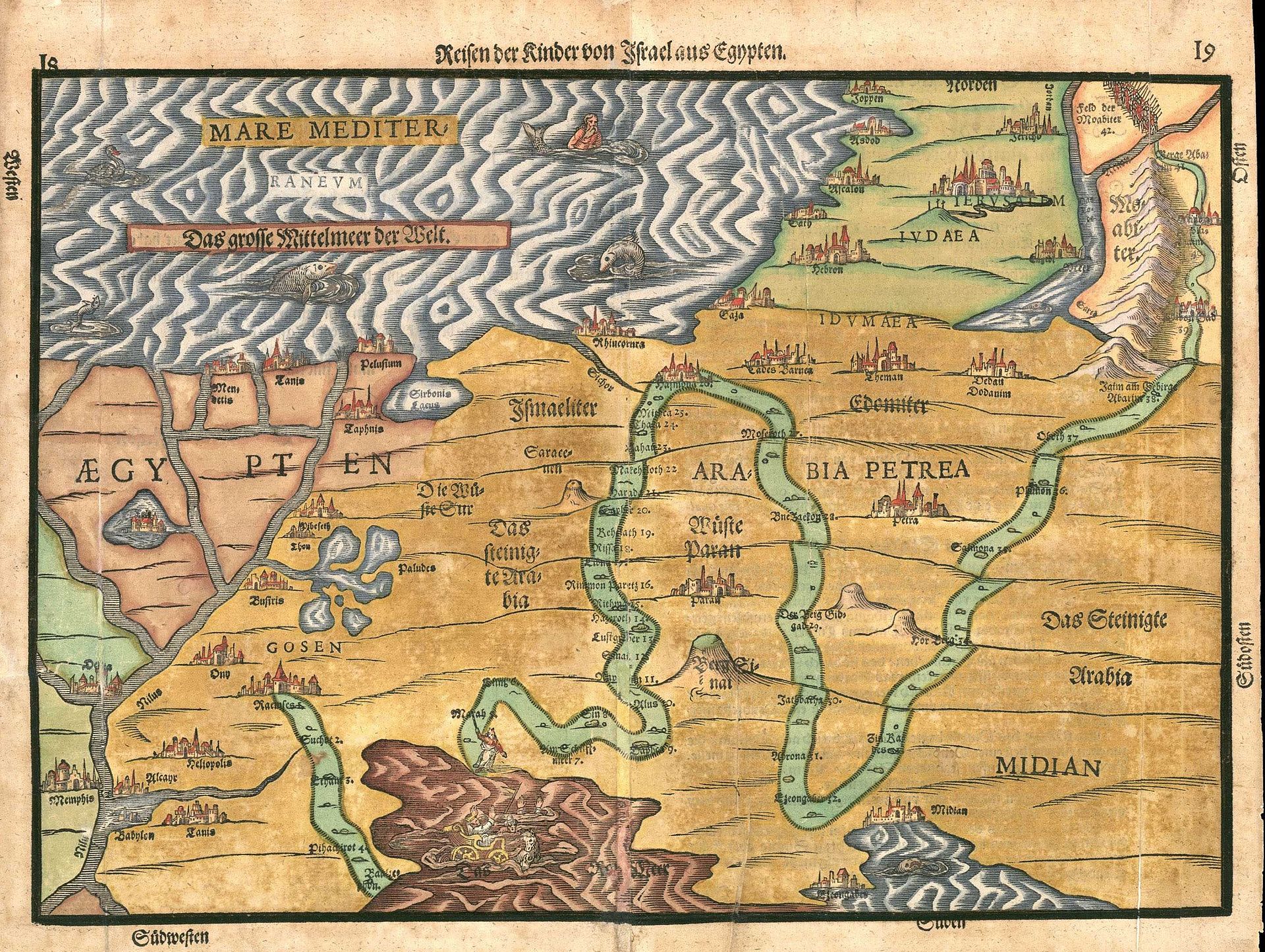 1585 map 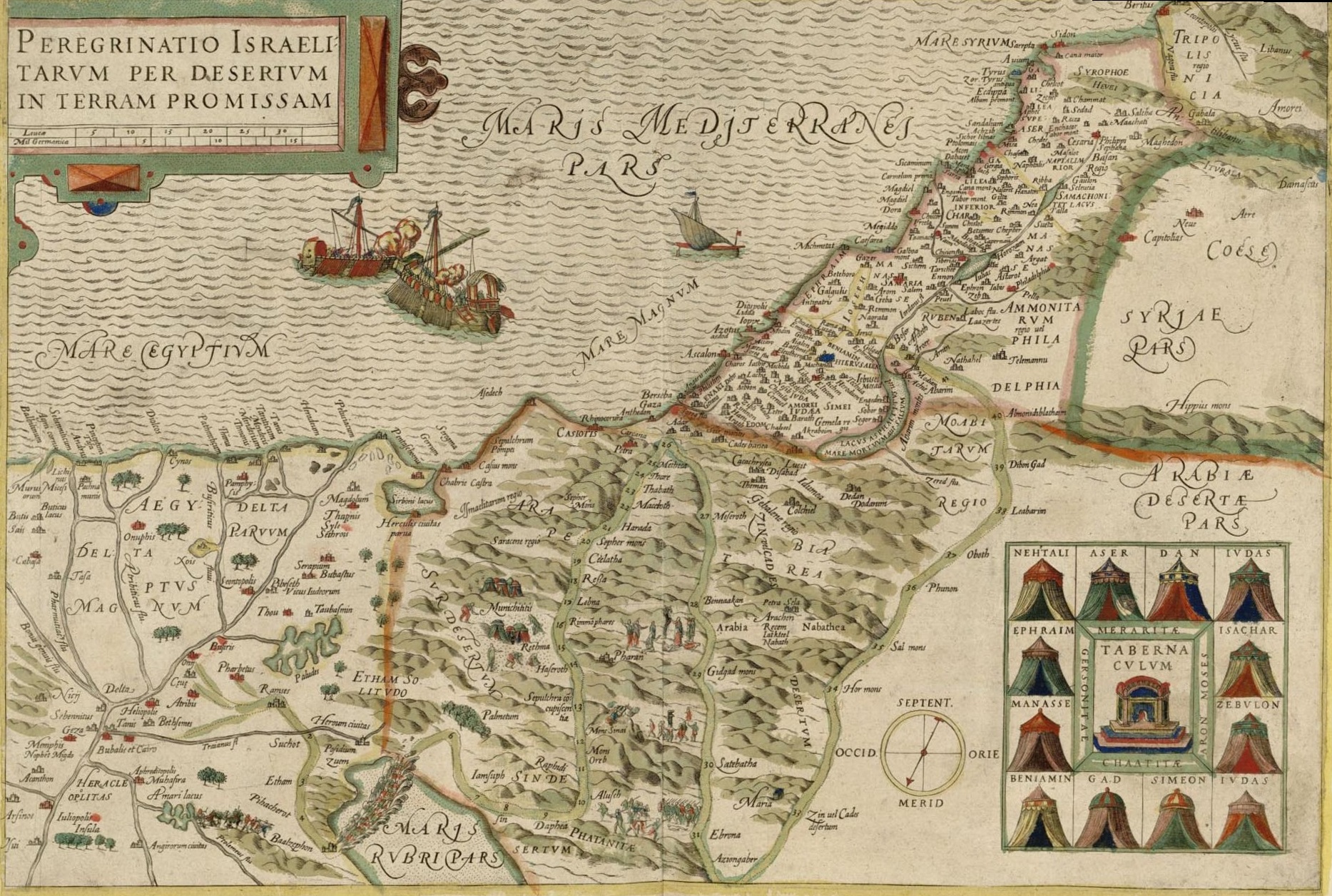 1641 map Historical representations of the Stations of the Exodus The text of the Book of Exodus begins after the events at the end of the Book of Genesis where Jacob's sons and their families joined their brother Joseph in Egypt, which Joseph had saved from famine. It is 400 years later and Egypt's new Pharaoh, who does not remember Joseph, is fearful that the enslaved and now numerous Israelites could become a fifth column. He hardens their labor and orders the killing of all newborn boys. A Levite woman named Jochebed saves her baby by setting him adrift on the Nile in an ark of bulrushes. Pharaoh's daughter finds the child, names him Moses, and brings him up as her own.  Finding of Moses in the Dura-Europos synagogue, c. 244 Later, a grown Moses goes out to see his kinsmen. He witnesses the abuse of a Hebrew slave by an Egyptian overseer. Angered, Moses kills him and flees into Midian to escape punishment. There, he marries Zipporah, daughter of Jethro, a Midianite priest. While tending Jethro's flock, Moses encounters God in a burning bush. Moses asks God for his name, to which God replies with three words, often translated as "I Am that I Am." This is the book's explanation for the origin of the name Yahweh, as God is thereafter known. God tells Moses to return to Egypt, free the Hebrews from slavery and lead them into Canaan, the land promised to the seed of Abraham in Genesis. On the journey back to Egypt, God seeks to kill Moses. Zipporah circumcises their son and the attack stops. (See Zipporah at the inn.) Moses reunites with his brother Aaron and, returning to Egypt, convenes the Israelite elders, preparing them to go into the wilderness to worship God. Pharaoh refuses to release the Israelites from their work for the festival, and so God curses the Egyptians with ten terrible plagues, such as a river of blood, an outbreak of frogs, and the thick darkness. Moses is commanded by God to fix the spring month of Aviv at the head of the Hebrew calendar. The Israelites are to take a lamb on the 10th day of the month, sacrifice the lamb on the 14th day, daub its blood on their mezuzot—doorposts and lintels, and to observe the Passover meal that night, during the full moon. The 10th plague comes that night, causing the death of all Egyptian firstborn sons, prompting Pharaoh to expel the Israelites. Regretting his decision, Pharaoh commands his chariot army after the Israelites, who appear trapped at the Red Sea. God parts the sea, allowing the Israelites to pass through, before drowning Pharaoh's pursuing forces. 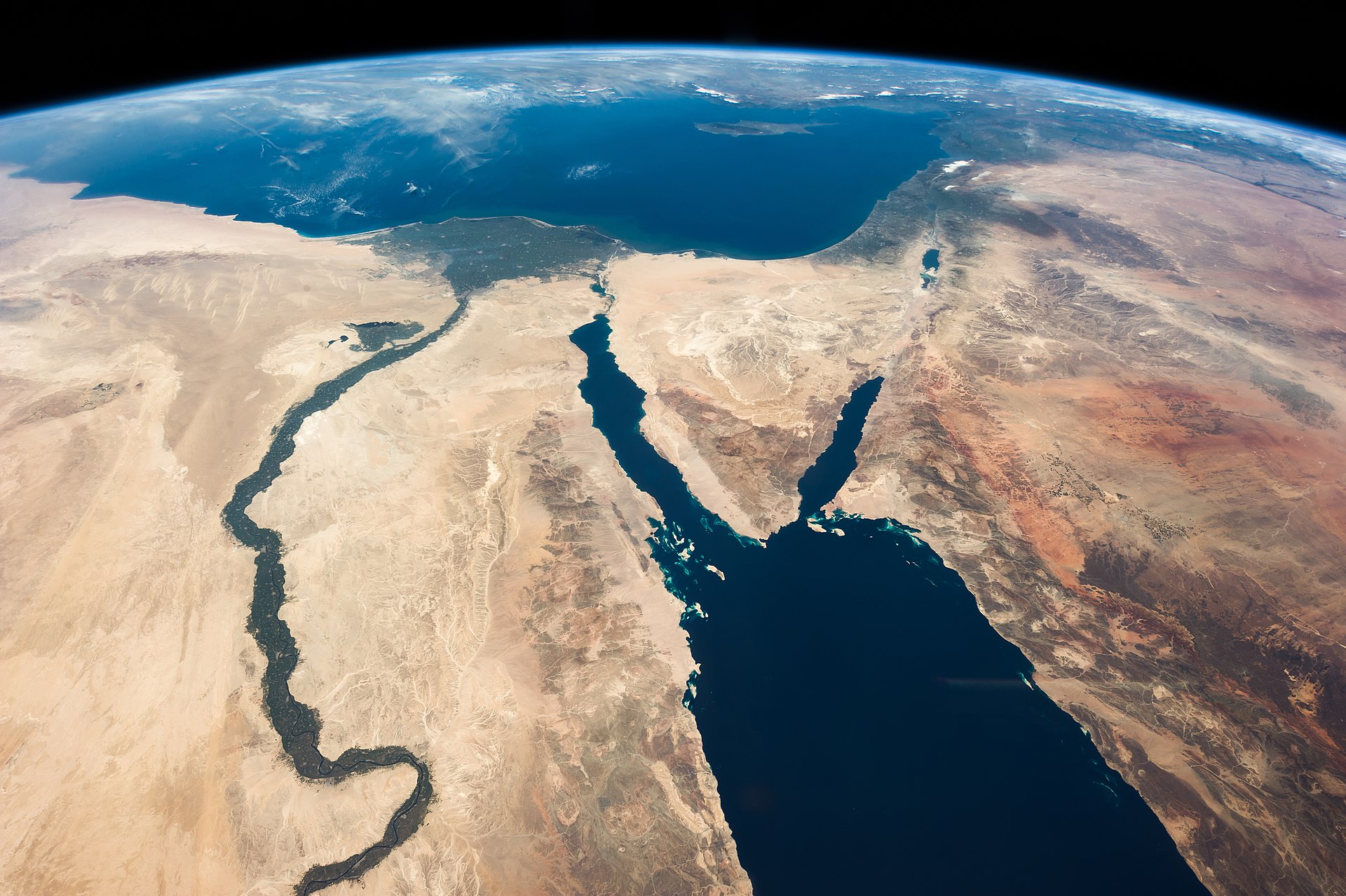 Geography of the Book of Exodus, with the Nile River and its delta, left, the Red Sea and Sinai desert, center, and the land of Israel, upper right As desert life proves arduous, the Israelites complain and long for Egypt, but God miraculously provides manna for them to eat and water to drink. The Israelites arrive at the mountain of God, where Moses's father-in-law Jethro visits Moses; at his suggestion, Moses appoints judges over Israel. God asks whether they will agree to be his people – They accept. The people gather at the foot of the mountain, and with thunder and lightning, fire and clouds of smoke, the sound of trumpets, and the trembling of the mountain, God appears on the peak, and the people see the cloud and hear the voice (or possibly sound) of God. God tells Moses to ascend the mountain. God pronounces the Ten Commandments (the Ethical Decalogue) in the hearing of all Israel. Moses goes up the mountain into the presence of God, who pronounces the Covenant Code of ritual and civil law and promises Canaan to them if they obey. Moses comes down from the mountain and writes down God's words, and the people agree to keep them. God calls Moses up the mountain again, where he remains for forty days and forty nights, after which he returns, bearing the set of stone tablets. God gives Moses instructions for the construction of the tabernacle so that God may dwell permanently among his chosen people, along with instructions for the priestly vestments, the altar and its appurtenances, procedures for the ordination of priests, and the daily sacrifice offerings. Aaron becomes the first hereditary high priest. God gives Moses the two tablets of stone containing the words of the ten commandments, written with the "finger of God".[19] 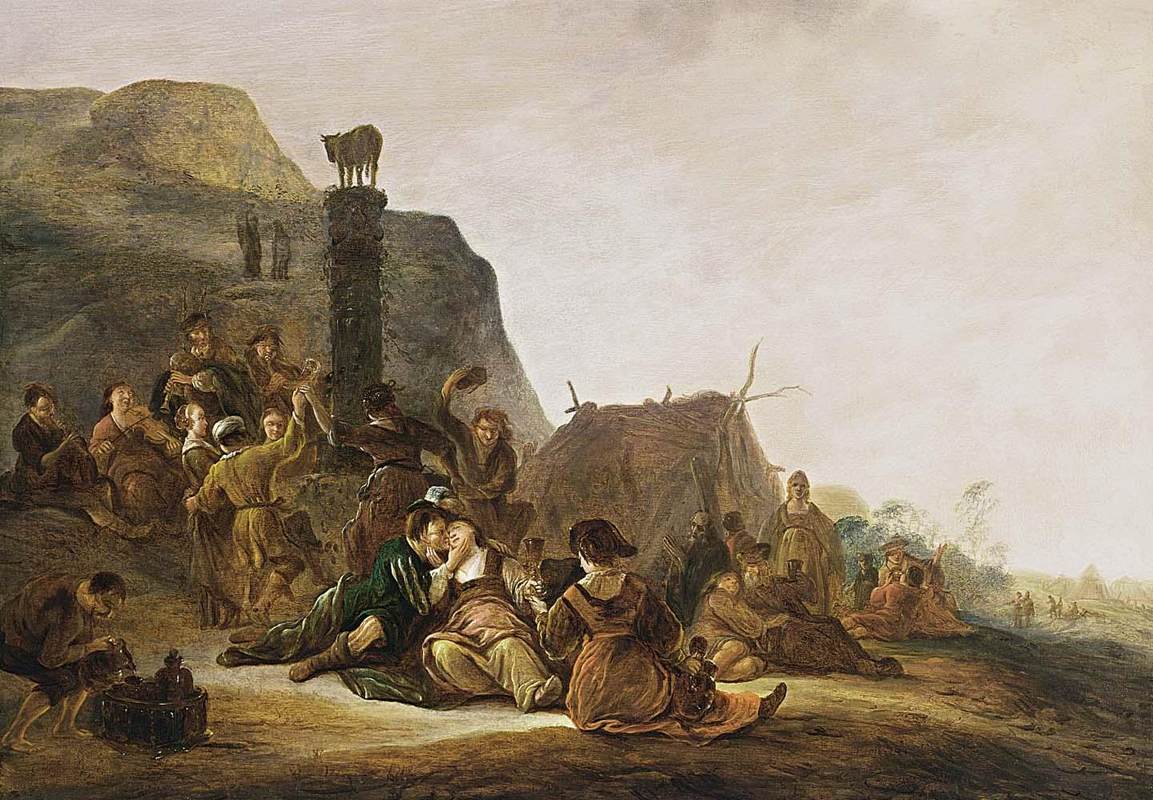 Worship of the Golden Calf, Gerrit de Wet, 17th century While Moses is with God, Aaron casts a golden calf, which the people worship. God informs Moses of their apostasy and threatens to kill them all, but relents when Moses pleads for them. Moses comes down from the mountain, smashes the stone tablets in anger, and commands the Levites to massacre the unfaithful Israelites. God commands Moses to construct two new tablets. Moses ascends the mountain again, where God dictates the Ten Commandments for Moses to write on the tablets. Moses descends from the mountain with a transformed face; from that time onwards he must hide his face with a veil. Moses assembles the Hebrews and repeats to them the commandments he has received from God, which are to keep the Sabbath and to construct the Tabernacle. The Israelites do as they are commanded. From that time God dwells in the Tabernacle and orders the travels of the Hebrews. |
概要 1585年地図  1641年の地図 出エジプトの歴史的表現 出エジプト記の本文は、創世記の終わり、ヤコブの息子たちとその家族が、ヨセフが飢饉から救ったエジプトで兄ヨセフと合流した出来事の後に始まる。それか ら400年後、ヨセフを覚えていないエジプトの新しいファラオは、奴隷にされ、今や多数のイスラエル人が第五列になることを恐れていた。彼は彼らの労働を 強化し、生まれたばかりの男の子を皆殺しにするよう命じた。ヨヘベドというレビ人の女性は、ナイル川を漂流する赤ん坊を灌木の箱舟に入れて救った。ファラ オの娘がその子を見つけ、モーセと名付け、自分の子として育てる。  ドゥラ・エウロポスのシナゴーグにおけるモーセの発見(244年頃 その後、成長したモーセは近親者に会いに出かける。モーセは、エジプト人監督によるヘブライ人奴隷の虐待を目撃する。怒ったモーセはその奴隷を殺し、罰か ら逃れるためにミディアンに逃げ込む。そこでモーセは、ミディアン人の祭司エテロの娘ジッポラと結婚する。エテロの群れの世話をしていたモーセは、燃える 柴の中で神に出会う。モーセが神に名を尋ねると、神はしばしば 「I Am that I Am 」と訳される3つの言葉で答えた。これが、以後神が知られるようになったヤハウェという名の由来についての、本書の説明である。神はモーセに、エジプトに 戻り、ヘブライ人を奴隷から解放し、創世記でアブラハムの子孫に約束された土地であるカナンへと導くよう告げる。エジプトに戻る途中、神はモーセを殺そう とする。ジッポラが息子に割礼を施すと、その攻撃は止む。(宿屋のジッポラを参照)。 モーセは弟のアロンと再会し、エジプトに戻ってイスラエルの長老たちを招集し、神を礼拝するために荒野に行く準備をさせる。ファラオはイスラエルの民を祭 りの仕事から解放することを拒んだため、神は血の川、カエルの大発生、濃い暗闇など10の恐ろしい災いでエジプト人を呪う。モーセは神から、春のアヴィヴ の月をヘブライ暦の先頭に据えるよう命じられる。イスラエルの民は、その月の10日に子羊を一頭連れて行き、14日目にその子羊を生け贄に捧げ、その血を メズゾット(門柱とまぐさ)に塗り、その夜、満月の間に過越の祭りの食事をする。その夜、第10の災いが起こり、エジプト人の長男がすべて死に、ファラオ はイスラエル人を追放した。ファラオは自分の決断を後悔し、紅海で捕らえられたイスラエルの民の後を追って戦車隊に命令を下す。神は海を裂き、イスラエル の民を通過させ、追ってきたファラオの軍勢を溺れさせた。  ナイル川とそのデルタ地帯(左)、紅海とシナイ砂漠(中央)、イスラエルの土地(右上)。 砂漠での生活は苦しく、イスラエルの民は不満を漏らし、エジプトに憧れを抱くが、神は奇跡的に彼らに食べるマンナと飲む水を与えた。イスラエルの民は神の 山に到着し、モーセの義父エテロがモーセを訪ね、彼の提案でモーセはイスラエルの裁判官を任命する。モーセの提案で、モーセはイスラエルの民に裁判官を任 命する。人々は山のふもとに集まり、雷と稲妻、火と煙、ラッパの音、山の震えとともに、神が山頂に現れ、人々は雲を見、神の声(あるいは音)を聞く。神は モーセに山に登るように言う。神は全イスラエルの聴衆の前で十戒(倫理十誡)を宣言する。モーセは山に登って神の御前に行き、神は儀式と民法の契約法典を 宣言し、彼らが従うならカナンを与えると約束する。モーセは山から下り、神の言葉を書き留め、民はそれを守ることに同意する。神はモーセを再び山に呼び寄 せ、四十日四十夜そこにとどまらせ、その後、モーセは石板を携えて戻ってくる。 神はモーセに、神が選ばれた民の間に永続的に住まわれるための幕屋の建設に関する指示と、祭司の法衣、祭壇とその付属品、祭司の叙階の手順、毎日のいけに えの捧げ物に関する指示を与える。アロンが最初の世襲大祭司となる。神がモーセに、「神の指」で書かれた十戒の言葉が書かれた二つの石板を与える [19]。  金の子牛の礼拝、ゲリット・デ・ウェット、17世紀 モーセが神とともにいる間、アロンは金の子牛を鋳造し、民はそれを拝む。神はモーセに彼らの背教を告げ、皆殺しにすると脅すが、モーセが彼らのために嘆願 すると容赦しなかった。モーセは山から下り、怒って石板を打ち砕き、レビ人に不忠実なイスラエル人を虐殺するよう命じる。神はモーセに新しい石版を2枚作 るよう命じる。モーセは再び山に登り、そこで神はモーセに石板に書くように十戒を指示する。 モーセは変貌した顔で山を下り、それ以降はベールで顔を隠さなければならない。モーセはヘブライ人を集め、神から受けた戒め、すなわち安息日を守ること、 幕屋を建てることを繰り返す。イスラエルの民は命じられたとおりにする。それ以来、神は幕屋に住まわれ、ヘブル人の旅を命じられた。 |
| Composition Authorship 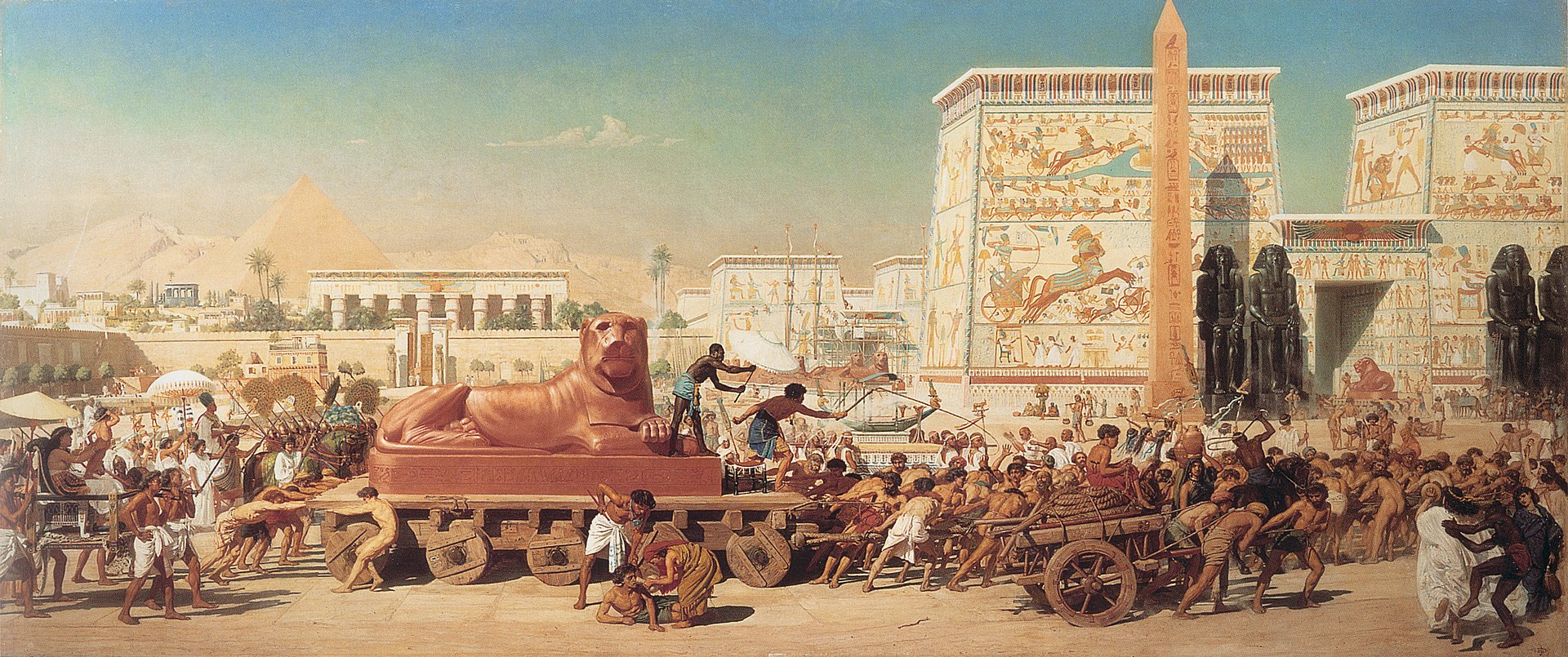 Children of Israel in Egypt (1867 painting by Edward Poynter) Jewish and Christian tradition viewed Moses as the author of Exodus and the entire Torah, but by the end of the 19th century the increasing awareness of discrepancies, inconsistencies, repetitions and other features of the Pentateuch had led scholars to abandon this idea.[20] In approximate round dates, the process which produced Exodus and the Pentateuch probably began around 600 BCE when existing oral and written traditions were brought together to form books recognizable as those we know, reaching their final form as unchangeable sacred texts around 400 BCE.[21] Sources This section relies largely or entirely upon a single source. Relevant discussion may be found on the talk page. Please help improve this article by introducing citations to additional sources at this section. (August 2022) (Learn how and when to remove this message) Although patent mythical elements are not so prominent in Exodus as in Genesis, ancient legends may have an influence on the book's form or content: for example, the story of the infant Moses's salvation from the Nile is argued to be based on an earlier legend of king Sargon of Akkad, while the story of the parting of the Red Sea may trade on Mesopotamian creation mythology. Similarly, the Covenant Code (the law code in Exodus 20:22–23:33) has some similarities in both content and structure with the Laws of Hammurabi. These potential influences serve to reinforce the conclusion that the Book of Exodus originated in the exiled Jewish community of 6th-century BCE Babylon, but not all the potential sources are Mesopotamian: the story of Moses's flight to Midian following the murder of the Egyptian overseer may draw on the Egyptian Story of Sinuhe.[22] Textual witnesses Main article: Textual variants in the Book of Exodus |
テキストの創造 作者  エジプトのイスラエルの子供たち(1867年、エドワード・ポインター画) ユダヤ教とキリスト教の伝統は、モーセを出エジプト記と律法全体の著者とみなしていたが、19世紀末になると、五書の矛盾、矛盾、繰り返し、その他の特徴 に対する認識が高まり、学者たちはこの考えを放棄するようになった[20]。 出エジプト記と五書が作られたプロセスは、おおよその年代で言えば、おそらく紀元前600年頃に始まり、既存の口頭伝承と文字伝承が統合されて、私たちが 知っているものと認識できる書物が形成され、紀元前400年頃に変更不可能な聖典として最終的な形に到達した[21]。 情報源 このセクションの大部分、または全体が単一の情報源に依存している。関連する議論はトークページにある。このセクションに追加ソースの引用を紹介することで、この記事の改善にご協力ください。(2022年8月) (このメッセージを削除する方法とタイミングを学ぶ) 例えば、幼いモーセがナイル川から救われた話は、アッカドのサルゴン王の伝説に基づくと主張されており、紅海を分けた話はメソポタミアの創造神話に基づく と考えられている。同様に、契約法典(出エジプト記20:22-23:33にある律法)は、内容的にも構造的にもハムラビ法と類似している。これらの潜在 的な影響は、出エジプト記が紀元前6世紀のバビロンの追放されたユダヤ人社会で生まれたという結論を補強しているが、すべての潜在的な出典がメソポタミア のものというわけではない。 テキスト上の証人 主な記事 出エジプト記のテキスト上の異同 |
Themes Departure of the Israelites by David Roberts (1829) Salvation Biblical scholars describe the Bible's theologically-motivated history writing as "salvation history", meaning a history of God's saving actions that give identity to Israel – the promise of offspring and land to the ancestors, the Exodus from Egypt (in which God saves Israel from slavery), the wilderness wandering, the revelation at Sinai, and the hope for the future life in the promised land.[23] Theophany A theophany is a manifestation (appearance) of a god – in the Bible, an appearance of the God of Israel, accompanied by storms – the earth trembles, the mountains quake, the heavens pour rain, thunder peals and lightning flashes.[24] The theophany in Exodus begins "the third day" from their arrival at Sinai in chapter 19: Yahweh and the people meet at the mountain, God appears in the storm and converses with Moses, giving him the Ten Commandments while the people listen. The theophany is therefore a public experience of divine law.[25] The second half of Exodus marks the point at which, and describes the process through which, God's theophany becomes a permanent presence for Israel via the Tabernacle. That so much of the book (chapters 25–31, 35–40) describes the plans of the Tabernacle demonstrates the importance it played in the perception of Second Temple Judaism at the time of the text's redaction by the Priestly writers: the Tabernacle is the place where God is physically present, where, through the priesthood, Israel could be in direct, literal communion with him.[26] Covenant 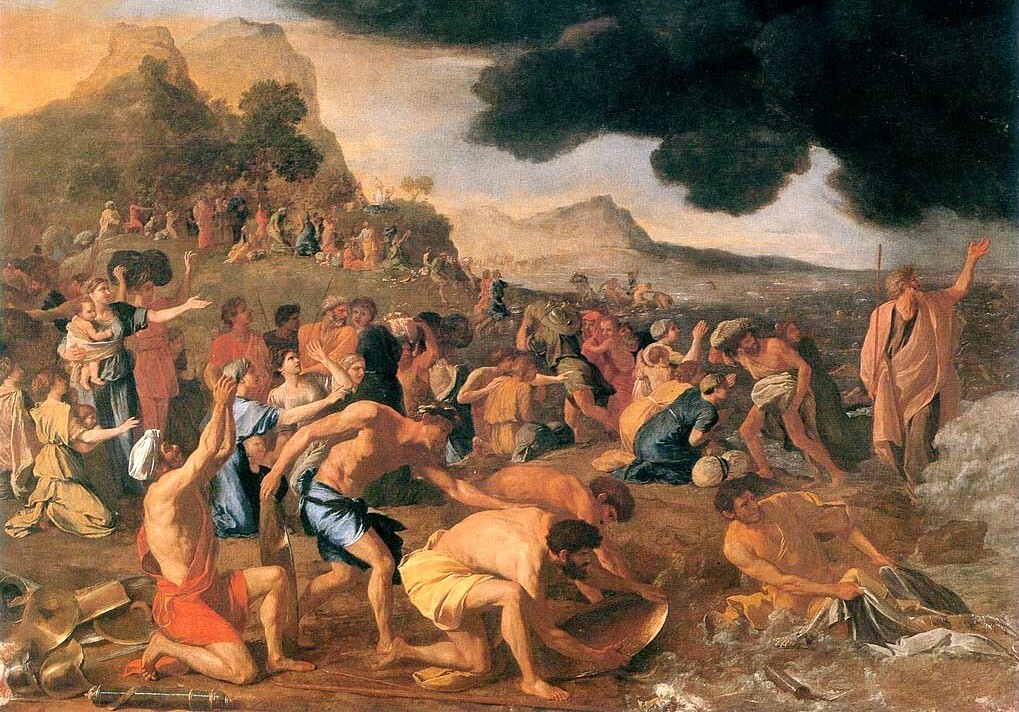 Crossing of the Red Sea, Nicolas Poussin The heart of Exodus is the Sinaitic covenant.[27] A covenant is a legal document binding two parties to take on certain obligations towards each other.[28] There are several covenants in the Bible, and in each case they exhibit at least some of the elements in real-life treaties of the ancient Middle East: a preamble, historical prologue, stipulations, deposition and reading, list of witnesses, blessings and curses, and ratification by animal sacrifice.[29] Biblical covenants, in contrast to Eastern covenants in general, are between a god, Yahweh, and a people, Israel, instead of between a strong ruler and a weaker vassal.[30] Election of Israel God elects Israel for salvation because the "sons of Israel" are "the firstborn son" of the God of Israel, descended through Shem and Abraham to the chosen line of Jacob whose name is changed to Israel. The goal of the divine plan in Exodus is a return to humanity's state in Eden, so that God can dwell with the Israelites as he had with Adam and Eve through the Ark and Tabernacle, which together form a model of the universe; in later Abrahamic religions Israel becomes the guardian of God's plan for humanity, to bring "God's creation blessing to mankind" begun in Adam.[31] |
テーマ イスラエルの民の旅立ち by デイヴィッド・ロバーツ (1829) 救い 聖書学者たちは、神学的な動機に基づいて書かれた聖書の歴史を「救いの歴史」と表現している。これは、イスラエルにアイデンティティを与える神の救いの行 動の歴史、つまり、先祖への子孫と土地の約束、エジプトからの出エジプト(この中で神はイスラエルを奴隷状態から救われた)、荒野の放浪、シナイでの啓 示、約束の地での将来の生活への希望などを意味する[23]。 神啓 出エジプト記』の神示は、19章のシナイ到着から「3日目」に始まる。ヤハウェと民は山で出会い、神は嵐の中に現れてモーセと対話し、民が耳を傾ける中で十戒を授ける。それゆえ、神示は神の掟の公の体験である[25]。 出エジプト記の後半は、神の神示が幕屋を通してイスラエルにとって恒久的な存在となる時点を示し、その過程を描写している。出エジプト記の大部分(25章 から31章、35章から40章)が幕屋の計画について記述されていることは、祭司職の著述家たちによって本文が再編集された当時、幕屋が第二神殿のユダヤ 教の認識において重要な役割を果たしていたことを示している。 契約  紅海の横断、ニコラ・プッサン 出エジプト記の中心はシナイトの契約である[27]。契約とは、2つの当事者が互いに一定の義務を負うことを拘束する法的文書である[28]。聖書にはい くつかの契約が登場するが、いずれの場合も、前文、歴史的プロローグ、規定、宣誓と朗読、証人のリスト、祝福と呪い、動物の犠牲による批准など、古代中東 の現実の条約に含まれる要素の少なくともいくつかを示している。 [29]聖書の契約は、一般的な東洋の契約とは対照的に、強い支配者と弱い家臣の間ではなく、神であるヤハウェと民であるイスラエルの間のものである [30]。 イスラエルの選出 神がイスラエルを救いのために選んだのは、「イスラエルの子ら」がイスラエルの神の「長子」であり、セム、アブラハムを経て、イスラエルと名を変えたヤコ ブの選ばれた血統に下るからである。出エジプト記における神の計画の目標は、エデンにおける人類の状態に戻ることであり、それによって神は、共に宇宙の模 範を形成する箱舟と幕屋を通してアダムとエバと共にあったように、イスラエルの民と共に住むことができる。後のアブラハム宗教においてイスラエルは、アダ ムにおいて始まった「神の創造の祝福」を人類にもたらす、神の人類に対する計画の守護者となる[31]。 |
| Judaism's weekly Torah portions in the Book of Exodus Main article: Weekly Torah portion 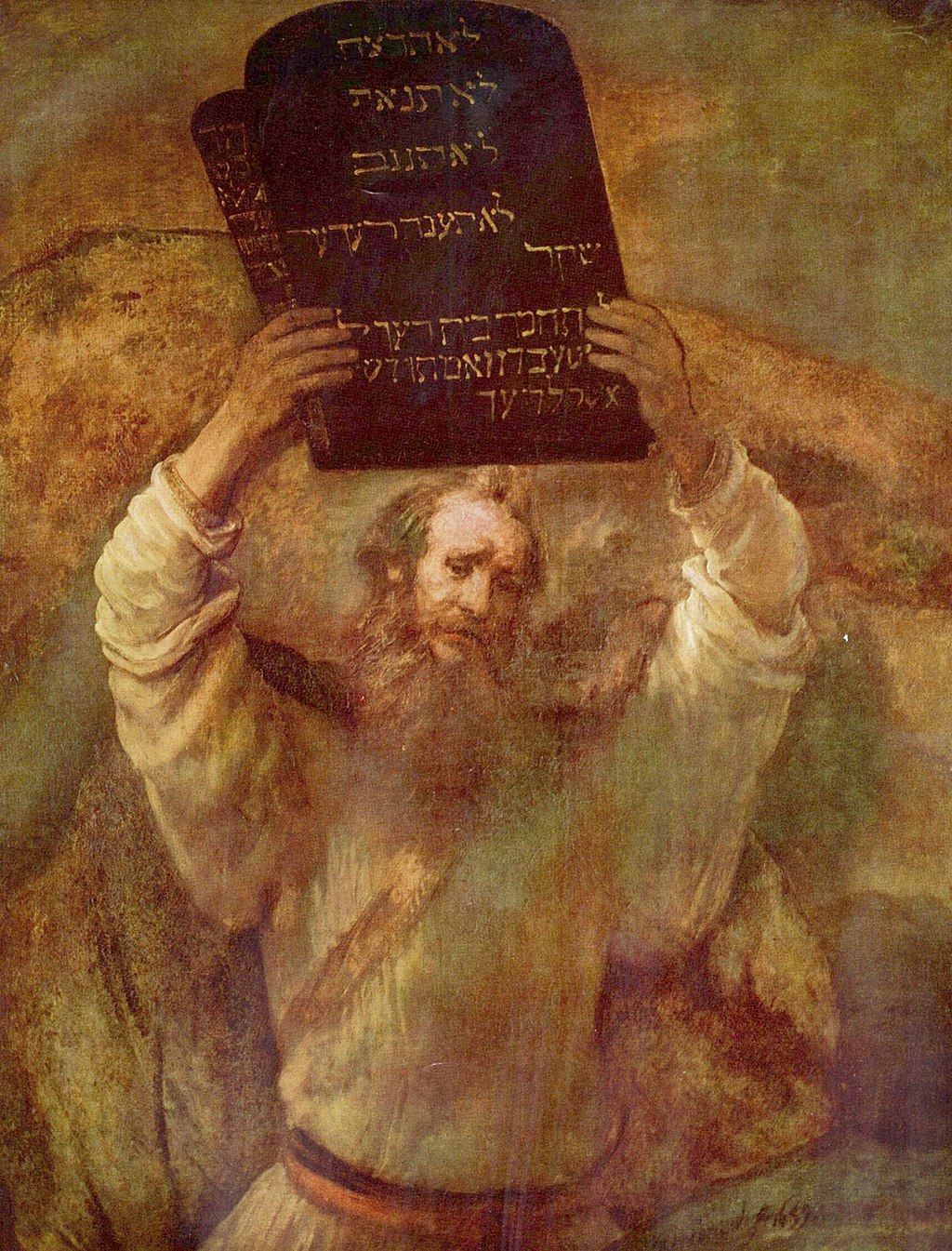 Moses with the Ten Commandments, by Rembrandt (1659) List of Torah portions in the Book of Exodus:[32] Shemot, on Exodus 1–5: Affliction in Egypt, discovery of baby Moses, Pharaoh Va'eira, on Exodus 6–9: Plagues 1 to 7 of Egypt Bo, on Exodus 10–13: Last plagues of Egypt, first Passover Beshalach, on Exodus 13–17: Parting the Sea, water, manna, Amalek Yitro, on Exodus 18–20: Jethro's advice, The Ten Commandments Mishpatim, on Exodus 21–24: The Covenant Code Terumah, on Exodus 25–27: God's instructions on the Tabernacle and furnishings Tetzaveh, on Exodus 27–30: God's instructions on the first priests Ki Tissa, on Exodus 30–34: Census, anointing oil, golden calf, stone tablets, Moses radiant Vayakhel, on Exodus 35–38: Israelites collect gifts, make the Tabernacle and furnishings Pekudei, on Exodus 38–40: Setting up and filling of The Tabernacle |
出エジプト記におけるユダヤ教の週ごとの律法分説 主な記事 週ごとの律法の部分  十戒を持つモーセ、レンブラント作(1659年) 出エジプト記のトーラー分説のリスト:[32]。 シェモト(出エジプト記1~5章:エジプトでの苦難、モーセの赤ん坊の発見、ファラオ ヴァエイラ(出エジプト記6~9章:エジプトの災い1~7章 ボ(出エジプト記10章~13章:エジプト最後の災い、最初の過越の祭り ベシャラク(出エジプト記13章~17章): 海の裂け目、水、マナ、アマレク イトロ(出エジプト記18章~20章:エテロの助言、十戒 ミシュパティム(出エジプト記21章~24章:契約の掟 テルマー(出エジプト記25章~27章:幕屋と調度品に関する神の指示 テツァベ(出エジプト記27章~30章:最初の祭司に関する神の指示 キ・ティッサ(出エジプト記30-34章):国勢調査、油注ぎの油、金の子牛、石板、モーセの輝き 出エジプト記35-38章「ヴァヤケル」:イスラエル人が贈り物を集め、幕屋と調度品を作る ペクデイ(出エジプト記38章~40章):幕屋の設置と盛り土 |
| Film adaptations of the Book of Exodus History of the Jews in Ancient Egypt Ketef Hinnom Song of the Sea List of individuals from the Book of Exodus |
出エジプト記の映画化 古代エジプトにおけるユダヤ人の歴史 ケテフ・ヒノム 海の歌 出エジプト記に登場する人物のリスト |
| bibliography Barmash, Pamela (2015). "Out of the Mists of History: The Exaltation of the Exodus in the Bible". In Barmash, Pamela; Nelson, W. David (eds.). Exodus in the Jewish Experience: Echoes and Reverberations. Lexington Books. pp. 1–22. ISBN 9781498502931. Childs, Brevard S (1979). The Book of Exodus. Eerdmans. ISBN 9780664229689. Collins, John J. (2005). The Bible After Babel: Historical Criticism in a Postmodern Age. Eerdmans. ISBN 9780802828927. Davies, Graham (2004). "Was There an Exodus?". In Day, John (ed.). In Search of Pre-exilic Israel: Proceedings of the Oxford Old Testament Seminar. Continuum. pp. 23–40. ISBN 9780567082060. Davies, Graham I. (2020). Exodus 1-18: A Critical and Exegetical Commentary: Volume 1: Chapters 1-10. International Critical Commentary. Bloomsbury Publishing. ISBN 978-0-567-68869-9. Davies, Graham I. (2020b). Exodus 1-18: A Critical and Exegetical Commentary: Volume 2: Chapters 11-18. International Critical Commentary. Bloomsbury Publishing. ISBN 978-0-567-68872-9. Dempster, Stephen G (2006). Dominion and Dynasty. InterVarsity Press. ISBN 9780830826155. Dozeman, Thomas B (2009). Commentary on Exodus. Eerdmans. ISBN 9780802826176. Dozeman, Thomas B (2000). "Exodus, Book of". In David Noel, Freedman; Allen C., Myers (eds.). Eerdmans Dictionary of the Bible. Eerdmans. ISBN 9789053565032. Dozeman, Thomas B. (2010). Methods for Exodus. Cambridge University Press. ISBN 9781139487382. Faust, Avraham (2015). "The Emergence of Iron Age Israel: On Origins and Habitus". In Thomas E. Levy; Thomas Schneider; William H.C. Propp (eds.). Israel's Exodus in Transdisciplinary Perspective: Text, Archaeology, Culture, and Geoscience. Springer. ISBN 978-3-319-04768-3. Finkelstein, Israel; Silberman, Neil Asher (2002). The Bible Unearthed. Simon and Schuster. ISBN 9780743223386. Fretheim, Terence E (1991). Exodus. Westminster John Knox Press. ISBN 9780664237349. Geraty, Lawrence T. (2015). "Exodus Dates and Theories". In Thomas E. Levy; Thomas Schneider; William H.C. Propp (eds.). Israel's Exodus in Transdisciplinary Perspective: Text, Archaeology, Culture, and Geoscience. Springer. pp. 55–64. ISBN 978-3-319-04768-3. Grabbe, Lester (2017). Ancient Israel: What Do We Know and How Do We Know It?. Bloomsbury. ISBN 978-0-567-67043-4. Houston, Walter J (1998). "Exodus". In John Barton (ed.). Oxford Bible Commentary. Oxford University Press. ISBN 9780198755005. Johnstone, William D. (2003). "Exodus". In James D. G. Dunn, John William Rogerson (ed.). Eerdmans Bible Commentary. Eerdmans. ISBN 9780802837110. Kugler, Robert; Hartin, Patrick (2009). An Introduction to the Bible. Eerdmans. ISBN 9780802846365. Levy, Thomas E., Thomas Schneider, William H.C. Propp. (2015). "Israel's Exodus in Transdisciplinary Perspective: Text, Archaeology, Culture, and Geoscience". Springer International Publishing. McEntire, Mark (2008). Struggling with God: An Introduction to the Pentateuch. Mercer University Press. ISBN 9780881461015. Meyers, Carol (2005). Exodus. Cambridge University Press. ISBN 9780521002912. Moore, Megan Bishop; Kelle, Brad E. (2011). Biblical History and Israel's Past. Eerdmans. ISBN 9780802862600. Noonan, Benjamin J. (2016). "Egyptian Loanwords as Evidence for the Authenticity of the Exodus and Wilderness Traditions". In Hoffmeier, James K.; Millard, Alan R.; Rendsburg, Gary A. (eds.). "Did I Not Bring Israel Out of Egypt?": Biblical, Archaeological, and Egyptological Perspectives on the Exodus Narratives. Penn State Press. pp. 49–67. ISBN 978-1-57506-430-7. Plaut, Gunther. The Torah: A Modern Commentary (1981), ISBN 0-8074-0055-6 Redmount, Carol A. (2001) [1998]. "Bitter Lives: Israel In And Out of Egypt". In Coogan, Michael D. (ed.). The Oxford History of the Biblical World. OUP. pp. 58–89. ISBN 9780199881482. Russell, Stephen C. (2009). Images of Egypt in Early Biblical Literature. Walter de Gruyter. ISBN 9783110221718. Shaw, Ian (2002). "Israel, Israelites". In Shaw, Ian; Jameson, Robert (eds.). A Dictionary of Archaeology. Wiley Blackwell. ISBN 9780631235835. Sparks, Kenton L. (2010). "Genre Criticism". In Dozeman, Thomas B. (ed.). Methods for Exodus. Cambridge University Press. ISBN 9781139487382. Stuart, Douglas K (2006). Exodus. B&H Publishing Group. ISBN 9780805401028. Wenham, Gordon (1979). The Book of Leviticus. Eerdmans. ISBN 9780802825223. |
|
| https://en.wikipedia.org/wiki/Book_of_Exodus |
リ ンク
文 献
そ の他の情報
Copyleft, CC, Mitzub'ixi Quq Chi'j, 1996-2099
☆
 ☆
☆